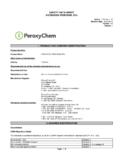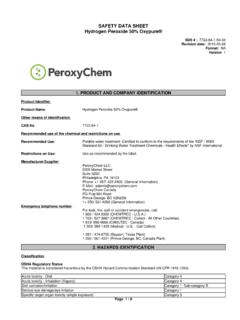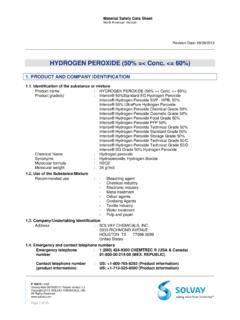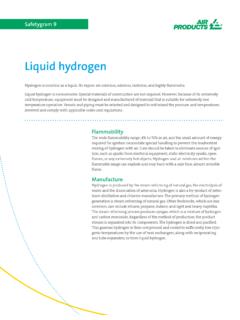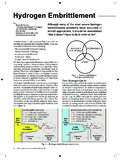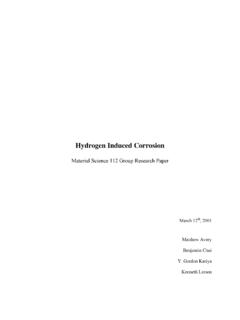Transcription of SAFETY DATA SHEET HYDROGEN PEROXIDE 35%
1 SAFETY DATA SHEET . HYDROGEN PEROXIDE 35%. SDS # : 7722-84-1--35. Revision date: 2015-03-18. Format: NA. Version 1. 1. PRODUCT AND COMPANY IDENTIFICATION. Product Identifier Product Name HYDROGEN PEROXIDE 35%. Other means of identification CAS-No 7722-84-1. Recommended use of the chemical and restrictions on use Recommended Use: Restrictions on Use: Use as recommended by the label. Manufacturer/Supplier PeroxyChem LLC. 2005 Market Street Suite 3200. Philadelphia, PA 19103. Phone: +1 267/ 422-2400 (General Information). E-Mail: PeroxyChem Canada PG Pulp Mill Road Prince George, BC V2N2S6. 1+ 250/ 561-4200 (General Information). Emergency telephone number For leak, fire, spill or accident emergencies, call: 1 800 / 424 9300 (CHEMTREC - ). 1 703 / 527 3887 (CHEMTREC - Collect - All Other Countries). 1 613/ 996-6666 (CANUTEC - Canada). 1 303/ 389-1409 (Medical - - Call Collect). 1 281 / 474-8750 (Bayport, Texas Plant). 1 250 / 561-4221 (Prince George, BC, Canada Plant). 2.
2 HAZARDS IDENTIFICATION. Classification OSHA Regulatory Status This chemical is considered hazardous by the 2012 OSHA Hazard Communication Standard (29 CFR ). Acute toxicity - Oral Category 4. Acute toxicity - Inhalation (Vapors) Category 4. Skin corrosion/irritation Category 2 Sub-category B. Serious eye damage/eye irritation Category 1. Page 1 / 9. HYDROGEN PEROXIDE 35%. SDS # : 7722-84-1--35. Revision date: 2015-03-18. Version 1. Specific target organ toxicity (single exposure) Category 3. Oxidizing Liquids Category 2. GHS Label elements, including precautionary statements EMERGENCY OVERVIEW. Danger Hazard Statements H318 - Causes serious eye damage H302 - Harmful if swallowed H332 - Harmful if inhaled H335 - May cause respiratory irritation H315 - Causes skin irritation H270 - May cause or intensify fire; oxidizer Precautionary Statements - Prevention P271 - Use only outdoors or in a well-ventilated area P261 - Avoid breathing mist/vapors/spray P280 - Wear protective gloves/ protective clothing/ eye protection/ face protection P210 - Keep away from heat/sparks/open flames/hot surfaces.
3 - No smoking P221 - Take any precaution to avoid mixing with combustibles/flammables P220 - Keep/Store away from clothing/flammable materials/combustibles Precautionary Statements - Response P305 + P351 + P338 - IF IN EYES: Rinse cautiously with water for several minutes. Remove contact lenses, if present and easy to do. Continue rinsing P310 - Immediately call a POISON CENTER or doctor P302 + P352 - IF ON SKIN: Wash with plenty of water and soap P332 + P313 - If skin irritation occurs: Get medical advice/ attention P362 + P364 - Take off all contaminated clothing and wash it before reuse P304 + P340 - IF INHALED: Remove person to fresh air and keep comfortable for breathing P312 - Call a POISON CENTER or doctor if you feel unwell P301 + P312 - IF SWALLOWED: Call a POISON CENTER or doctor if you feel unwell P330 - Rinse mouth P370 + P378 - In case of fire: Use water for extinction Hazards not otherwise classified (HNOC). No hazards not otherwise classified were identified.
4 Other Information Keep container in a cool place out of direct sunlight. Store only in vented containers. Do not store on wooden pallets. Do not return unused material to its original container. Avoid contamination - Contamination could cause decomposition and generation of oxygen which may result in high pressure and possible container rupture. Empty drums should be triple rinsed with water before discarding.. Page 2 / 9. HYDROGEN PEROXIDE 35%. SDS # : 7722-84-1--35. Revision date: 2015-03-18. Version 1. 3. COMPOSITION/INFORMATION ON INGREDIENTS. Formula HO - OH. Chemical name CAS-No Weight %. HYDROGEN PEROXIDE 7722-84-1 35. Water 7732-18-5 65. Occupational exposure limits, if available, are listed in section 8. 4. FIRST AID MEASURES. Eye Contact Rinse immediately with plenty of water, also under the eyelids, for at least 15 minutes. Remove contact lenses, if present, after the first 5 minutes, then continue rinsing. Seek immediate medical attention/advice. Skin Contact Take off contaminated clothing.
5 Rinse skin immediately with plenty of water for 15-20. minutes. Call a poison control center or doctor for further treatment advice. Inhalation Move to fresh air. If person is not breathing, contact emergency medical services, then give artificial respiration, preferably mouth-to-mouth if possible. Call a poison control center or doctor for further treatment advice. Ingestion Rinse mouth. Do not induce vomiting. If conscious, give 2 glasses of water. Get immediate medical attention. Never give anything by mouth to an unconscious person. Most important symptoms and In case of accidental ingestion, necrosis may result from mucous membrane burns (mouth, effects, both acute and delayed esophagus and stomach). Oxygen rapid release may cause stomach swelling and hemorrhaging, which may product major, or even fatal, injury to organs if a large amount has been ingested. In case of skin contact, may cause burns, erythema, blisters or even necrosis. HYDROGEN PEROXIDE irritates respiratory system and, if inhaled, may cause inflammation and pulmonary edema.
6 The effects may not be immediate. Indication of immediate medical HYDROGEN PEROXIDE at these concentrations is a strong oxidant. Direct contact with the eye attention and special treatment is likely to cause corneal damage especially if not washed immediately. Careful needed, if necessary opthalmologic evaluation is recommended and the possibility of local corticosteroid therapy should be considered. Because of the likelihood of corrosive effects on the gastrointestinal tract after ingestion, and the unlikelihood of systemic effects, attemps at evacuating the stomach via emesis induction or gastric lavage should be avoided. There is a remote possibility, however, that a nasogastric or orogastric tube may be required for the reduction of severe distension due to gas formation. 5. FIRE-FIGHTING MEASURES. Suitable Extinguishing Media Water. Do not use any other substance. Specific Hazards Arising from the In closed unventilated containers, risk of rupture due to the increased pressure from Chemical decomposition.
7 Contact with combustible material may cause fire Hazardous Combustion Products On decomposition product releases oxygen which may intensify fire. Explosion data Sensitivity to Mechanical Impact Not sensitive. Sensitivity to Static Discharge Not sensitive. Protective equipment and Use water spray to cool fire exposed surfaces and protect personnel. Move containers from precautions for firefighters fire area if you can do it without risk. As in any fire, wear self-contained breathing apparatus and full protective gear. 6. ACCIDENTAL RELEASE MEASURES. Page 3 / 9. HYDROGEN PEROXIDE 35%. SDS # : 7722-84-1--35. Revision date: 2015-03-18. Version 1. Personal Precautions Avoid contact with skin, eyes and clothing. Wear personal protective equipment. Isolate and post spill area. Keep people away from and upwind of spill/leak. Eliminate all sources of ignition and remove combustible materials. Other Combustible materials exposed to HYDROGEN PEROXIDE should be immediately submerged in or rinsed with large amounts of water to ensure that all HYDROGEN PEROXIDE is removed.
8 Residual HYDROGEN PEROXIDE that is allowed to dry (upon evaporation HYDROGEN PEROXIDE can concentrate) on organic materials such as paper, fabrics, cotton, leather, wood or other combustibles can cause the material to ignite and result in fire. Environmental Precautions Do not flush into surface water or sanitary sewer system; if discharged into sewers or watercourses, dilute with plenty of water. See Section 12 for additional Ecological Information. Methods for Containment Dike to collect large liquid spills. Stop leak and contain spill if this can be done safely. Small spillage: Dilute with large quantities of water. Methods for cleaning up Flush area with flooding quantities of water. HYDROGEN PEROXIDE may be decomposed by adding sodium metabisulfite or sodium sulfite after diluting to about 5%. 7. HANDLING AND STORAGE. Handling Keep/Store away from clothing/ combustible materials. Wear personal protective equipment. Reference to other sections. Never return unused HYDROGEN PEROXIDE to original container.
9 Contamination may cause decomposition and generation of oxygen gas which could result in high pressures and possible container rupture. Empty drums should be triple rinsed with water before discarding. Utensils used for handling HYDROGEN PEROXIDE should only be made of glass, stainless steel, aluminum or plastic. Pipes and equipment should be passivated before first use. Use only in well-ventilated areas. HYDROGEN PEROXIDE should be stored only in vented containers and transferred only in a prescribed manner. Storage Keep containers in cool areas out of direct sunlight and away from combustibles. Provide mechanical general and/or local exhaust ventilation to prevent release of vapor or mist into work environment. Containers must be vented. Keep/store only in original container. Store rooms or warehouses should be made of non-combustible materials with impermeable floors. In case of release, spillage should flow to safe area. Containers should be visually inspected on a regular basis to detect any abnormalities (swollen drums, increases in temperature, etc.)
10 Incompatible products Combustible materials. Copper alloys, galvanized iron. Strong reducing agents. Heavy metals. Iron. Copper alloys. Contact with metals, metallic ions, alkalis, reducing agents and organic matter (such as alcohols or terpenes) may produce self-accelerated thermal decomposition. 8. EXPOSURE CONTROLS/PERSONAL PROTECTION. Control parameters Exposure Guidelines Ingredients with workplace control parameters. Chemical name ACGIH TLV OSHA PEL NIOSH Mexico HYDROGEN PEROXIDE TWA: 1 ppm TWA: 1 ppm IDLH: 75 ppm Mexico: TWA 1 ppm 7722-84-1 TWA: mg/m3 TWA: 1 ppm Mexico: TWA mg/m3. TWA: mg/m3 Mexico: STEL 2 ppm Mexico: STEL 3 mg/m3. Chemical name British Columbia Quebec Ontario TWAEV Alberta HYDROGEN PEROXIDE TWA: 1 ppm TWA: 1 ppm TWA: 1 ppm TWA: 1 ppm 7722-84-1 TWA: mg/m3 TWA: mg/m3. Appropriate engineering controls Page 4 / 9. HYDROGEN PEROXIDE 35%. SDS # : 7722-84-1--35. Revision date: 2015-03-18. Version 1. Engineering measures Ensure that eyewash stations and SAFETY showers are close to the workstation location.
